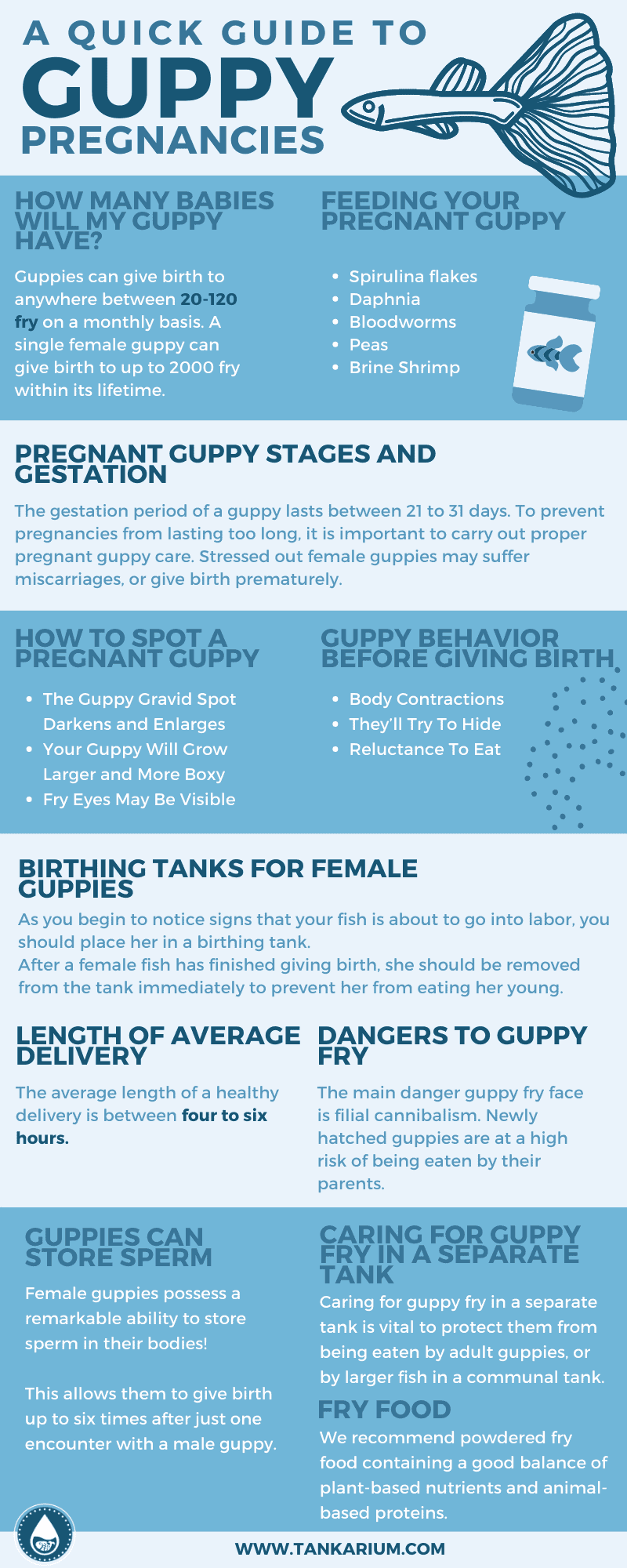Guppies are one of the most popular fish in the world for both beginners and experienced fishkeepers alike. With their dizzying array of colors and variety, they make beautiful additions to freshwater tanks.
To add to their appeal, these livebearing fish are also extremely easy to breed. In this article, we explore how to care for a pregnant guppy through every stage of its pregnancy!
Guppy Breeding Behavior
Guppy owners often find themselves with multiple generations of fish in their tank after a short period of time. This has a lot to do with the mating behavior of these prolific breeders.
Male guppies mature after they reach 7 weeks of age, after which they will begin to mate with female guppies. As part of the mating ritual, male guppies perform a series of “dances” to show off their colors and patterns in the hopes of attracting a female’s attention.
When a female guppy is receptive, she turns and approaches the male in a response to his bid for attention. Female guppies are able to give birth several times after just one encounter with a male fish, while male fish are able to inseminate multiple females over the course of a single day.
How Many Babies Will My Guppy Have?
Guppies can give birth to anywhere between 20-120 fry on a monthly basis. A single female guppy can give birth to up to 2000 fry within its lifetime.
Because they breed so rapidly, it is important to make sure you have enough room in your tank to house multiple generations of guppies. Individuals who do not intend to breed their guppies should separate the males and females. Here’s a quick guide on how to tell between the two.
Feeding Your Pregnant Guppy
A prerequisite for healthy baby guppy fish is a healthy mother. When female guppies are pregnant, they require small frequent meals throughout the day. These meals should consist of high-quality vegetables and protein. Our top recommendations:
- Spirulina flakes
- Daphnia
- Bloodworms
- Peas
- Brine Shrimp
While fish flakes and pellets may meet the nutritional requirements of most guppies, pregnant fish typically benefit from an enhanced diet. Therefore, we recommend supplementing the existing diets of your fish with the natural alternatives listed above.
Pregnant Guppy Stages And Gestation
Many beginners wonder how to tell if a guppy is pregnant. One of the first signs is the development of a guppy gravid spot near the base of the mother’s anal fin. This spot appears dark yellow at first, and will continue to darken as the pregnancy progresses.
At this point, you might wonder – How long are guppies pregnant for? The gestation period of a guppy lasts between 21 to 31 days. To prevent pregnancies from lasting too long, it is important to carry out proper pregnant guppy care. Stressed out female guppies may suffer miscarriages, or give birth prematurely.
How To Spot A Pregnant Guppy
The Guppy Gravid Spot Darkens And Enlarges
The gravid spot is a dark spot located right beside the anal fin in female guppies, and is typically used as a visual indicator of a pregnant fish. As the fry within the female’s belly develops, the gravid spot stretches to become larger and darker.
Your Guppy Will Grow Larger And More Boxy
Over the course of the pregnancy, your female guppy will gradually take on a larger and more boxy appearance. While this may cause her to look like a bloated guppy, rest assured that this is just what a pregnant guppy looks like.
Fry Eyes May Be Visible
At the end of your fish’s gestation period, fry eyes may become visible through the skin of the mother’s abdomen. This also causes the gravid spot to appear darker. Congratulations! You’ll have guppy fry swimming about in your tank really soon!
Guppy Behavior Before Giving Birth (What Are The Pregnant Guppy Signs Of Delivery)
It is important to spot the signs that a female guppy is about to give birth. This allows you to create a safe environment for both the mother and the babies. While the signs of an impending delivery may vary between guppies, there are three common signs to look out for:
Body Contractions
A guppy that is about to deliver may experience contractions as she prepares to push her fry out of her body. Contractions may cause your fish to look like she is trembling or shuddering. This is usually a sign that your fish is about to go into labor.
They’ll Try To Hide
Guppies can sense when they’re about to give birth, and will do their best to find a safe, secluded spot within the tank where they can deliver in peace. Hiding is unusual for guppies as they are outgoing little creatures, which is why this behavior stands out as a sign that your fish is about to go into labor.
Reluctance To Eat
Going into labor is a stressful experience. Therefore, guppies that are about to give birth may demonstrate a reluctance to eat. If this is the case with your fish, do make sure to pay extra attention to her.
Guppies Giving Birth
Birthing Tanks for Female Guppies
Birthing tanks are an essential component of a stress-free delivery for your guppy. As you begin to notice signs that your fish is about to go into labor, you should place her in a birthing tank. Being able to give birth in a birthing tank provides the mother with a safe space as she delivers her babies.
After a female fish has finished giving birth, she should be removed from the tank immediately to prevent her from eating her young. Thereafter, she should be fed nutritious food to replenish her energy.
Length of Average Delivery
The average length of a healthy delivery is between four to six hours. Guppy fry that are born healthy will swim upwards, while weaker or stillborn guppies fall to the bottom of the tank. Healthy deliveries maximize the odds of survival for guppy fry.
Guppies that are more stressed out may take up to 12 hours to give birth to their young. There are also births that take longer than 12 hours – these are considered extreme cases. Unfortunately, these births yield very few surviving fry.
Dangers to Guppy Fry
The main danger guppy fry face is filial cannibalism. Newly hatched guppies are at a high risk of being eaten by their parents.
There are multiple theories on why guppies eat their young. Some individuals hypothesize that mothers do so to replenish their energy after giving birth. Others assert that guppies do so to weed out the weak.
Whatever their reasons may be, our advice remains the same – separate guppy fry from other fish in the tank.
Guppies Can Store Sperm
As you develop a plan to breed your guppies, you should bear one thing in mind: Female guppies possess a remarkable ability to store sperm in their bodies!
This allows them to give birth up to six times after just one encounter with a male guppy. After that, you can expect your female guppies to give birth in consecutive 30-day cycles.
Of course, the frequency at which female guppies give birth means that you need to be prepared to house your guppy fry. Make sure you have a spare tank to keep them safe after they are born!
Fry Care And Feeding
Caring for Guppy Fry In A Separate Tank
The first thing you should do after your guppy gives birth is to separate its fry from other adult guppies. You can do so by isolating the female guppy in a separate tank right before she gives birth, and removing her immediately after.
Caring for guppy fry in a separate tank is vital to protect them from being eaten by adult guppies, or by larger fish in a communal tank.
If you lack a spare tank, you can also use a breeding box. Just be sure not to house your fry in these boxes for prolonged periods, as the limited space may stump their growth!
Fry Food
Guppy fry are tiny, and require specialized fry food that are tiny and easily digestible. We recommend powdered fry food containing a good balance of plant-based nutrients and animal-based proteins.
It is recommended that you feed your fry in a separate tank in the initial stages of their growth. Fry that are too young and inexperienced might not be able to compete with their larger tankmates for food. This will significantly impact their odds of survival.
Conclusion
Guppies are some of the most remarkable fish in the world because they are hardy, colorful, and easy to breed. A thoughtful plan to care for your pregnant guppies can ensure that you have a tankful of healthy fish on your hands.
Following the tips article is a great place to start. Be sure to share this article with someone who is thinking of breeding their guppies!



Excellent! Best article on the internet on guppy breeding! Cheers from Singapore!
Excellent description. Great job.
Thanks for info! This has truly helped me get more info on my preggo guppies!